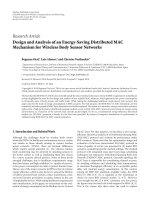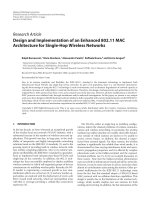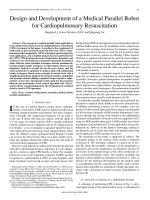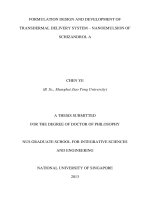Design and development of an autonomous omni directional mobile robot
Bạn đang xem bản rút gọn của tài liệu. Xem và tải ngay bản đầy đủ của tài liệu tại đây (6.82 MB, 76 trang )
DESIGN AND DEVELOPMENT OF AN AUTONOMOUS
OMNI-DIRECTIONAL MOBILE ROBOT
SEAN EFREM SABASTIAN
(B.Eng.(Hons.)), NUS
A THESIS SUBMITTED
FOR THE DEGREE OF MASTER OF ENGINEERING
DEPARTMENT OF MECHANICAL ENGINEERING
NATIONAL UNIVERSITY OF SINGAPORE
2011
Acknowledgements
The author would like to thank the following people for their contribution in my
endeavor for perfection:
My Loving Parents
For giving me everything that I need, hoped for and even more. For always being
patient and understanding my need to be in NUS constantly. Even though sometimes I
do not see them for days, they never fail to ensure there is food on my plate, shelter
over my head and love in the home.
My Supervisor, Marcelo Ang H. Jr.
For your nurturing guidance in overseeing this project with much patience and resolve
and for allowing me to pursue research in my interest something that I have been
yearning for since being an undergraduate. Not only that, thank you for being down to
earth and the coolest professor there is. Last, but definitely not the least, believing in
me when I did not. Salamat.
My good friend, Tomasz Marek “Jeff” Lubecki
For having high expectations of yourself and everyone around you. That is essentially
what allowed me to finish this project. I dedicate this project to you because without
you, I really don’t think I would be able to finish. Numerous times when I felt I could
not move on, let alone, finish this project but your, “Are you stupid or are you crazy?”
pushed me to eat the humble pie and this has changed my view on learning in life.
i
Although we were initially introduced as lab mates, we have grown to be really good
friends of which I am grateful for and something that I truly cherish. Dziekuje.
Ever friendly and approachable Lab Technicians:
Ms Hamidah “Milk Tea” Bte Jasman, Ms Ooi-Toh “Life is like that” Chew Hoey, Mr
Sakthiyavan “You understand?” s/o Kuppusamy, Ms Tshin “It’s ok one la.”Oi Meng
and Mr Yee “What do you think?” Choon Seng, Laboratory Staff, Department of
Mechanical Engineering:
For their much needed help in getting the tools and components that greatly facilitated
the progress of the project and it gave me great joy and satisfaction in working with
them.
ii
Table of Contents
Acknowledgements..................................................................................................................... i
Table of Contents...................................................................................................................... iii
Summary ................................................................................................................................... vi
List of Tables ........................................................................................................................... viii
List of Figures .......................................................................................................................... viii
1. Introduction ........................................................................................................................... 1
1.1 Omnidirectional Vehicles ................................................................................................. 1
1.2 Motivations...................................................................................................................... 2
1.3 Objectives ........................................................................................................................ 3
1.4 Outline ............................................................................................................................. 3
2. Kinematics.............................................................................................................................. 5
3. Mechanical Design ...............................................................................................................10
3.1 Mechanical System ........................................................................................................10
3.1.1 Structure..................................................................................................................10
3.1.2 DC Motor & Encoder ...............................................................................................13
3.1.3 Infrared ...................................................................................................................14
3.1.4 Sonars......................................................................................................................15
3.1.5 Digital Compass ...................................................................................................... 16
3.1.6 Bump sensors ..........................................................................................................16
3.1.7 Cost .........................................................................................................................17
4. Electronic design ..................................................................................................................18
4.1 Microcontroller ..............................................................................................................18
4.2 H-Bridge .........................................................................................................................20
4.3 Catch Diodes ..................................................................................................................21
4.4 Current Measurement - Calibration ..............................................................................22
4.5 Current Measurement – Linearisation...........................................................................22
iii
4.6 Problems Faced – Current Overload..............................................................................24
4.7 Problems Faced – Hard modifications ...........................................................................26
5. Software Architecture..........................................................................................................28
5.1 IDE – Libraries ................................................................................................................29
5.2 Master Processor ...........................................................................................................30
5.3 Slave Processor ..............................................................................................................31
5.4 Real Time Control...........................................................................................................31
5.4.1 Embedded Systems .................................................................................................32
5.4.2 Multiprocessors – Distributed processing ...............................................................32
5.4.3 Scheduler – Varying Frequency and priority ...........................................................32
5.4.4 Critical Section – different level of Interrupts .........................................................33
5.4.5 Semaphore – flags for execution.............................................................................33
5.5 GUI – Libraries................................................................................................................33
5.5.1 Problems faced – Corrupted Data...........................................................................36
5.5.2 Problems faced – Data/Timing Synchronization.....................................................36
5.6 Control ...........................................................................................................................37
5.6.1 Control Algorithm....................................................................................................37
5.6.2 Displacement...........................................................................................................38
6. Navigation Experiments and Performance Analysis ............................................................39
6.1 Overview ........................................................................................................................39
6.2 Mathematical Representation .......................................................................................39
6.2.1 Attractive Potential Field ........................................................................................40
6.2.2 Repulsive Potential Field .........................................................................................40
6.3 Implementation .............................................................................................................41
6.4 Overall Performance ......................................................................................................42
6.4.1 Translational Motion...............................................................................................42
6.4.2 Rotational Motion...................................................................................................43
6.4.3 Translational and Rotational motion ......................................................................45
6.4.4 Local Navigation I....................................................................................................47
6.4.5 Local Navigation II...................................................................................................49
6.4.6 Discussion on overall design ...................................................................................50
7. Conclusion............................................................................................................................53
iv
7.1 Future Works .................................................................................................................54
7.1.1 Controller ................................................................................................................54
7.1.2 Navigational Computation Environment ................................................................54
7.1.3 Improved Navigation Algorithm .............................................................................54
7.1.4 Vision.......................................................................................................................55
Bibliography .............................................................................................................................56
APPENDIX A – Sensors Placement ...........................................................................................58
APPENDIX B – Mechanical Bumper..........................................................................................59
APPENDIX C – Current Measurement......................................................................................60
APPENDIX D – Infrared Characteristics ....................................................................................61
APPENDIX E – Ride7 & Flash Loader ........................................................................................62
APPENDIX F – 3D functions......................................................................................................63
APPENDIX G - Scheduler ..........................................................................................................64
APPENDIX H – Patent Application............................................................................................66
APPENDIX I – Bill of Materials..................................................................................................67
.
v
Summary
The objective of this M Eng work is the design and development of a low-cost omnidirectional mobile robot that has specific required abilities that will aid it in its safe
autonomous navigation in an unknown environment.
Some of the abilities are omni-directional motion capability that allows it to be
holonomic, ground edge detection capabilities that will prevent the robot from
experiencing a fall, obstacle avoidance which is essential as it moves to a goal
location, carry a note book that will serve as a higher level control which will allow
wireless communication, navigation computation and a platform for further
developments (such as the attachment of a camera for vision processing) and collision
detection so that the robot will be aware that it has collided into an obstacle.
A microcontroller has been custom designed for the low-level control of the mobile
robot architecture. It consists of three ARM Cortex-M processors that will
communicate with the three actuators and sensors on the robot. The two Slave
processors on board have also been programmed to communicate reliably with a
Master processor which will be the gateway for communication to the notebook for
higher-level control. The communication protocol between the microcontroller and
the notebook has also been set up. It will send data which will be used in the
navigation computation, writing to file and be displayed on a Graphical User Interface
(GUI) which has also been written.
vi
With the aim of this project to be low cost, reliable working components were
obtained where possible and fabrication was done in-house by the author. The robot’s
mechanical design is built from scratch and having three wheels, the kinematics of
motion that relates the overall robot’s velocity and the individual wheel’s velocities
has been derived. A control algorithm of the actuator has been implemented and
shows good performance. A navigation algorithm has also been implemented and
efficacy has been demonstrated.
Performance analysis has been performed and
drawbacks to both the control and navigation algorithm are discussed. This
autonomous holonomic robot is also meant to serve as a platform for future
developments and it is described in this thesis.
vii
List of Tables
Table 1: Process Priority..........................................................................................................31
List of Figures
Figure 1: Kinematic Diagram of robot........................................................................................ 5
Figure 2: Close-up translational velocity at wheel 1.................................................................. 6
Figure 3: (a)(b)Three wheel vs Four Wheel (c) Interolls Wheels .............................................10
Figure 4: 3D Computer Aided design .......................................................................................11
Figure 5: Top View of Mobile Platform....................................................................................12
Figure 6: (a) Before (b) After....................................................................................................12
Figure 7: Third Platform and Bumper ......................................................................................13
Figure 8: (a) Gear (b) DC Motor (c) Encoder, HEDS5540 .........................................................14
Figure 9: SHARP GP2D120 with a 100µF Capacitor .................................................................15
Figure 10(a) SRF 05 (b) SRF 08 .................................................................................................15
Figure 11: Digital Compass CMPS09 ........................................................................................16
Figure 12: Limit switch used as a bump sensor .......................................................................16
Figure 13: Microcontroller .......................................................................................................18
Figure 14: (a) Location of Processors (b) Crystals ...................................................................19
Figure 15: (a) 5 x Digital I/Os each (b) 5 x Analog I/Os ............................................................19
Figure 16: H-Bridges and Encoder Interface ............................................................................20
Figure 17: (a) Forward Direction (b) Reverse Direction (c) MOSFETs......................................21
Figure 18: (a) Varying Duty Cycle .............................................................................................21
Figure 19: (left to right) Measurement of PWM & Op-amp output, Current Probe Waveform
.................................................................................................................................................23
Figure 20: Power Resistors and Inductors to simulate a motor ..............................................23
Figure 21: (a) Inductor on veraboard (b) Underside connection (c) Inductor for motors.......26
Figure 22: Hard Modification...................................................................................................27
Figure 23: Overall Architecture................................................................................................28
Figure 24: Screenshot of GUI developed .................................................................................34
Figure 25: Program Flow for Higher Level Control ..................................................................35
Figure 26: Data Frame..............................................................................................................36
Figure 27: PID Control Block ....................................................................................................37
Figure 28: Navigation Flow ......................................................................................................41
Figure 29: X-Y goal & X-Y Trajectory ........................................................................................42
Figure 30: Wheel's Reference & Actual Velocities...................................................................43
Figure 31: Bearing Command for strict rotational motion ......................................................44
Figure 32: Individual wheel’s velocities for strict rotational motion.......................................44
Figure 33: Translational trajectory for combined motion .......................................................45
Figure 34; Rotational trajectory for combined motion............................................................46
Figure 35: Individual wheel’s reference and actual velocities for combined motion..............46
Figure 36: Local Navigation I – Forward...................................................................................47
Figure 37: Local Navigation I - Reverse ....................................................................................48
Figure 38: Local Navigation II where robot does not reach goal point....................................49
viii
1. Introduction
1.1 Omnidirectional Vehicles
The very first omnidirectional wheel was patented in 1919 by J. Grabowiecki in the
US [1]. Appendix H shows an image from the patent application. Even as early as
1907, inventors were considering the design of vehicles capable of moving forward
and sideways without steering the wheels [2]. One of the first modern omnidirectional
wheels was developed by the Swedish inventor Bengt Ilon around 1973 [3]. Although
it was patented at an early stage, the traditional Ackerman steering still dominated the
field of mobile vehicles/robots [18]. These can also be seen in our everyday
automobiles. However, omni-directional wheels are getting more popular due to its
unique ability of being able to translate and rotate at the same time and move in any
direction at any given point in time. This is especially useful in confined spaces where
there is limited mobility. An example would be doing parallel parking with only a
length of the vehicle’s space available. A traditional vehicle with Ackermann steering
vehicle would not be able to park as quickly and efficiently as an omnidirectional
vehicle.
Omnidirectional wheels can be seen in robotics, industry, and logistics. The main
sources of omnidirectional wheels are companies which produce them for
omnidirectional conveyor systems, for example, for handling packages. Some
examples would be Interoll and Kornylak[4][5]. A company that has applied this
technology in the industry is AirTrax. AirTrax build forklifts that use these wheels for
the transportation of goods in a warehouse[6].
1
Another field in which omnidirectional capabilities is popular is Robocup (Robot
Soccer Competition, [7]). In this field, they are desirable because it is not hampered
by non-holonomic constraints and is capable to maneuver in between robotic players
in a soccer field robots are put into action, especially in confined or congested spaces
[7].
A recent novel omnidirectional wheel is the gimbaled wheel which seems to be able
to provide motion control using a single actuator and a single wheel[19]. It utilizes a
hemispherical wheel spinning like a spinning top. So for example, if the hemisphere is
spinning clockwise, looking from above, tilting it so that the right side contacts the
ground will "pull" the robot/vehicle forward, with the amount of torque directly
proportional to the tilt of the hemisphere, like an infinite gear ratio without any gears.
It assumes a single point of contact with the ground, and thus requires a flat, hard
floor. This is limiting [20]. Not only that, it has been tested on lego robots and it is
now known whether is able to handle greater amount of loading as it is intended for a
car-sized version to be built.
1.2 Motivations
The drive behind the design and development from scratch is to be able to understand
and appreciate the ability to articulate the lower level and, at the same time, be able to
have higher level control to be implemented on it. This will allow a research
framework to be established from which further research may be conducted; be it for
research in more advanced navigation algorithm, advance motion control, motion
tracking using a camera, swarm robots in cooperation or remote surveillance. Lowlevel control would be defined as work relating to the PCB microcontroller which
2
would be the PWM signal to the motors, reading of the various sensors and the interprocessor communication. High Level control would be work relating to the laptop
PC which would be reading of information sent by the microcontroller, writing of
velocity commands and the navigational strategy implemented based on code written
and ran on the laptop PC.
1.3 Objectives
To further extend the ability of these mobile robots effectively, the mobile robots
should be able to keep track of their current position (localization), sense their
surroundings (perception) and be able to reach its destination (navigation) in a timely
fashion. These formulate the objective for this low cost research platform. This robot
must be assembled within the budget allocated which is $3500. Not only that, the
robot must:
1. Be Omni-directional, with a maximum safety linear translational speed of 1m/s and
a maximum rotational speed of 20deg/s.
2. Be able to avoid static obstacles in an unknown static environment.
3. Know it has come in contact with objects
4. Detect the edge of a table, to avoid sudden fall of the robot
5. Be able to carry a mini-notebook for higher level computation and a payload of
50kg.
1.4 Outline
In this dissertation, the kinematics behind a three wheeled omnidirectional platform
will be introduced in Chapter 2. This will relate the robots global or local velocity to
the individual wheels’ velocities. In Chapter 3, the robots mechanical design will be
3
explained together with the various actuators and sensors utilized. In addition, the
electronic design behind the custom designed microcontroller will be revealed and
various problems faced and how they were addressed. Lastly, the software
programming flow for both the low and high level control will be detailed. Aspects of
Real Time Low Level Control methodology will also be touched on. The control
algorithm used to control the DC Motors will be explained in Chapter 4 and the
navigation and performance evaluation will be discussed in Chapter 5. The last
chapter will be the conclusion on what has been done and what can be done to
improve the overall system.
4
2. Kinematics
In this section, the kinematics involved in a three-wheeled configuration is formally
introduced. In order to prescribe the robot’s movements in the environment,
knowledge of how these variables relate to the primary variables that can be
controlled is required: the angular positions and velocities of the wheel shafts.
Therefore, a kinematical model of the robot has to be developed.
V1
V1y
Φ'1
V1x
Y1
Φ'3
Y'
X1
R
θ
X'
V3
V2
y
Φ'2
θ
x
Figure 1: Kinematic Diagram of robot
To begin the kinematics derivation, a global frame [x, y] which represents the
environment of the robot needs to be defined, see Figure 1. The robot’s location and
orientation in this global frame can be represented as(x, y, θ). The global velocity of
.
.
.
the robot can be written as ( x , y , θ ).
A local frame [xL, yL] is also defined that is attached to the robot itself. The center of
this local frame coincides with the center of gravity of the robot. The three
omniwheels are located at an angle αi (i = 1, 2, 3) relative to the local frame. If we
5
take the local axis xL as starting point and count degrees in the clockwise direction as
positive, we have α1 = 0°, α2 = 120° and α3 = 240°.
From Figure 1, it is obvious that the elements that connect the environment with the
robot are the wheel hubs and are thus a good starting point for a kinematic relation.
The translational velocities of the wheels vi on the floor determine the global velocity
.
.
.
of the robot in the environment ( x , y , θ ) and vice versa. The translational velocity
of wheel hub vi can be divided into a part due to pure translation of the robot and a
part due to pure rotation of the robot:
νi =νtrans, i +νrot
(2.1)
First, pure translation will be considered. In Figure 2, a close-up of vtrans,1, the
translational velocity at wheel hub 1, is shown. We can map the unit vector vtrans,1 onto
.
.
the vectors x , and y to obtain (2.5).
Figure 2: Close-up translational velocity at wheel 1
.
.
νtrans ,1 = − sin(θ ) x + cos(θ ) y
(2.2)
This vector mapping for all wheels is generalize when we take into consideration that
the vectors vi are positioned at an offset θ+αi . Therefore, it can be written as such:
6
.
.
νtrans ,1 = − sin(θ + αi ) x + cos(θ + αi ) y
(2.3)
When the platform executes a pure rotation, the hub speed vi needs to satisfy the
following equation:
.
νrot = R θ
(2.4)
Here R is the distance from the center of gravity of the robot to the wheels along a
radial path. R = 0.17m. When both influences in (2.1) are substituted, the following is
produced:
.
.
.
νi = − sin(θ + αi ) x + cos(θ + αi ) y + Rθ
(2.5)
The translational velocity of the wheels are now coupled to the global velocities of the
omnidirectional platform. The translational velocity of the hub is related to the
.
angular velocity φ i of the wheels through:
.
νi = r φ i
(2.6)
where r is the radius of an omnidirectional wheel: 0.08m. Thus (2.6) can be subtitued
in (2.5) to obtain:
1
r
.
.
.
.
φ i = − sin(θ + αi ) x + cos(θ + αi ) y + R θ
(2.7)
(2.7) can be transformed to matrix representation (2.8) and (2.9):
.
.
φ = Jinv U
(2.8)
7
In this relation, Jinv is the inverse Jacobian for the omnidirectional robot that provides
.
a direct relationship between the angular velocities of the wheels
φ
and the global
.
velocity vector U .
.
.
R x
cos(θ )
− sin(θ )
φ. 1
.
φ 2 = 1 − sin(θ + α 2) cos(θ + α 2) R y
.
. r
− sin(θ + α 3) cos(θ + α 3) R θ
φ 3
(2.9)
In most cases, it is not convenient for users to steer a robot in global coordinates
however. It is far more natural to think and steer in local coordinates. Fortunately,
global coordinates can be converted to local coordinates with the following equation:
.
.
x
θ
θ
cos(
)
sin(
)
0
−
.
x.L
y = sin(θ ) cos(θ ) 0 yL
.
.
θL
0
0
1
θ
(2.10)
Substituting equation (2.10) in (2.9) leads to:
.
.
cos(θ )
R cos(θ ) − sin(θ ) 0 xL
− sin(θ )
φ. 1
.
φ 2 = 1 − sin(θ + α 2) cos(θ + α 2) R sin(θ ) cos(θ ) 0 yL (2.11)
.
. r
θL
θ
α
θ
α
−
sin(
+
3
)
cos(
+
3
)
R
0
0
1
φ 3
This matrix relation in the local frame can also be expanded to three separate
equations for easy implementation in programming applications:
.
1
r
.
.
φ 1 = yL + R θ
(2.12)
8
.
.
1
φ 2 = [cos(θ + α 2) sin(θ ) − sin(θ + α 2) cos(θ )] xL +
r
.
.
[sin(θ + α 2) sin(θ ) + cos(θ + α 2) cos(θ )] yL + R θ
.
.
1
φ 3 = [cos(θ + α 3) sin(θ ) − sin(θ + α 3) cos(θ )] xL +
r
.
.
[sin(θ + α 3) sin(θ ) + cos(θ + α 3) cos(θ )] yL + R θ
9
3. Mechanical Design
3.1 Mechanical System
3.1.1 Structure
In this section, the motivation behind the structure and the changes made to the design
to make it more robust under budget constraints are discussed. In this section, the
conceptual design of motion, sensing and the overall structural design is presented. To
decrease the overall cost, a three-wheeled configuration, instead of four, will be
chosen. The drawback is that it cannot carry a heavier payload and the chance of it
tipping is greater as shown in Figure 3(a) and 3(b). Interolls plastic wheels are chosen
as they are cheap and they can satisfy a load of 250N each[4].
(a)
(b)
(c)
Figure 3: (a)(b)Three wheel vs Four Wheel (c) Interolls Wheels
A computer aided design (Figure 4) was visualized and constructed. This allowed a
better understanding in the design and details of the various parts be it the screws,
dimensions and materials. The three actuators are located on the lower platform and
three profiled aluminum bars acts as both the holder for the sensors and as well as the
pillar of support for the upper level. The upper level has a gap for wires for power to
the actuators, sensors and microcontroller as well as USB communication to a laptop
PC.
10
Figure 4: 3D Computer Aided design
All mechanical components were obtained and fabricated in house by the author. If a
certain machining job had some complexity, help was sought from the Fabrication
Support Centre (FSC), National University of Singapore (NUS). The initial structure
consists of two platforms made from two pieces of 50x50cm High Density
Polyethylene (HDPE). This was obtained as scrap material found among workshops
in NUS. It was then machined to be in a circle so that any rotational movements
would not cause any different length size if say the platform would like to pass
through tight spaces. Also, all sensors are positioned in such a way that it would not
be damaged if the 0.5m diameter mobile robot collides with any obstacles as seen in
Figure 5.
11
Figure 5: Top View of Mobile Platform
Some changes made from the initial design, in Figure 6(a), is the addition of a bearing
at the end of the motor shaft and the placement of the actuator unit below the lower
platform, seen in Figure 6(b). This would allow greater clearance between the
platform and the ground and a greater load bearing of the platform. The payload of
90kg is based on the maximum motor shaft load and the housed bearing. This is
limited to 50kg for safety concern.
(a)
(b)
Figure 6: (a) Before (b) After
12
(a)
(b)
Figure 7: Third Platform and Bumper
In addition, a third metal platform was added to not only support the laptop PC but to
provide a cheap form of partial shielding from the laptop PC’s hard drive which
would affect readings from the digital compass. The digital compass was placed
above the second platform as the magnetic interference from the DC Motor was
significant.
8 metal brackets are also added that would extend the coverage of the bumping
sensing. These are the green colored metal brackets covered with black padding on
the lower platform seen in Figure 7(b). Not only is it rigid but it provides 360 degrees
sensing ability. These metal brackets, required some experimenting with the brackets
to find the appropriate design that fits the mobile platform. (APPENDIX B shows
details of the metal brackets.)
3.1.2 DC Motor & Encoder
The three actuators used are 70 Watt DC Faulhaber Motors. The motor has a no load
speed of 5300rpm and stall torque of 0.51Nm. They each have a gear and an encoder.
The Gear ratio is 3.71:1. The DC Motor is controlled by using a H-Bridge which will
13
be discussed in Section 3.2. Encoder signals are obtained from the encoder and are fed
into the microcontroller as digital signals.
(a)
(b)
(c)
Figure 8: (a) Gear (b) DC Motor (c) Encoder, HEDS5540
3.1.3 Infrared
SHARP infrared sensors are chosen for this project as they are proven to be reliable
and they used in conjunction with sonars. The infrared has a point based distance
ranging while sonars have a cone style distance ranging. Both have pros and cons. An
infrared would not be able to detect the chair of a leg while sonar would be able to.
On the other hand, an infrared would be able to detect a way through a door way
while sonar would not. The SHARP GP2D120, Figure 9, has an official minimum
distance of 4cm but can range down to 2cm. This allows the sensors to be placed near
the edge of the robot. It has an official maximum range of 30cm but it can range up to
80cm though with much fluctuations. A capacitor is placed across the supply voltage
and ground to smooth fluctuations caused by the load as seen in Figure 9. Value
chosen is 100µF for the capacitor as recommended in its manual [9]. The sensors
provide an analog signal and its voltage/distance relationship has to be linearized and
it seen in APPENDIX D (b). Three sensors shall be used to detect the ground (to
prevent the robot from falling) and three shall be used for ranging.
14
Figure 9: SHARP GP2D120 with a 100µF Capacitor
3.1.4 Sonars
Devantech Ultrasonic sensors are chosen as they are cheap, accurate and flexible in
programming. Three sensors shall be mounted on the structural beam and three shall
be attached to the top platform. To cut down on cost, four sonars that Control and
Mechatronics Laboratory already have shall be used. Two more sonars are required.
These are SRF 08 which are very powerful sonars capable of ranging up to six meters.
Both models provide digital signals but there are two advantages using SRF08.
SRF05 requires a timer to measure the Pulse Width Modulation (PWM) provided by
the sensor to obtain the distance while the SRF08 does not need it [10]. Also, the
SRF05 requires a dedicated I/O pin for one device while the SRF08 uses I2C protocol
[11]. This allows up to 32 devices to be connected to the just two I/O pins. They are
chosen over SRF08 as they are cheaper and range of four meters is suitable for indoor
navigation. As such there are four SRF08 and two SRF05.
(a)
(b)
Figure 10(a) SRF 05 (b) SRF 08
15
3.1.5 Digital Compass
The digital compass is used to provide a form of absolute bearing to the mobile
platform. The compass used is a Devantech CMPS09 which has already be precalibrated at the factory. This compass is severely affected by external magnetic
interference such as DC Motors and the hard disk from a laptop PC. As such, it is
placed on the second platform of mobile robot. This provides the most stable location
for reading it. This compass can be read through PWM, serially or through I2C. This
compass will be read through I2C as this would allow it to share a common bus with
the SRF08 [12].
Figure 11: Digital Compass CMPS09
3.1.6 Bump sensors
The Control and Mechatronics Laboratory provides these limit switches and these will
not cost anything towards the budget of this project. As seen in Appendix A, eight
switches shall be used as bump contact. These are connected in such a way that they
are active high when switched on. These would provide digital signal to the
microcontroller that would serve as an external interrupt when the mobile robot comes
in contact with an obstacle.
Figure 12: Limit switch used as a bump sensor
16









